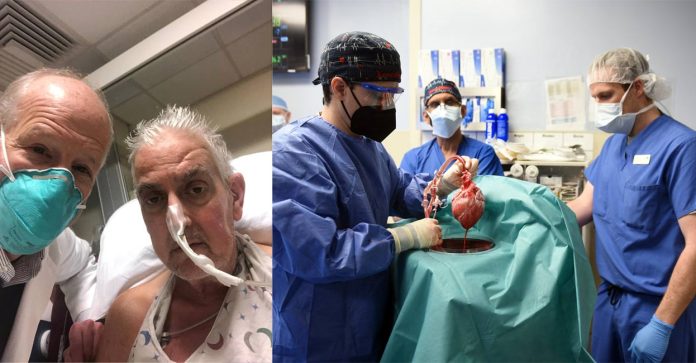
Doctors in the US have transplanted a genetically-modified pig heart into a dying patient in a world-first.
David Bennett, 57, underwent the nine-hour experimental procedure at the University of Maryland Medical Center in Baltimore on Saturday.
Surgeons used a heart from a pig that had undergone gene-editing to remove a sugar in its cells that would have increased the risk of his body rejecting it.
Mr Bennet is breathing on his own while still connected to a heart-lung machine to help his new heart pump blood around his body.
Experts say it is too soon to know if his body will fully accept the organ and the next few weeks will be critical as he is weaned off the machine.
But, if successful, it would mark a medical breakthrough and could save thousands of lives in the US alone each year.
Mr Bennett, a labourer, knew there was no guarantee the operation would work but had terminal heart failure and was too sick to qualify for a human transplant.
A day before his surgery, Mr Bennet said it was ‘either die or do this transplant’, adding: ‘I want to live. I know it’s a shot in the dark, but it’s my last choice.’
There is a huge shortage of human organs donated for transplant in the US, driving scientists to try to figure out how to use animal organs instead.
Nearly 120,000 Americans are in need of healthy organs and on average 20 people die each day waiting for one to become available.
Last year, there were just over 3,800 heart transplants in the US, a record number, according to the United Network for Organ Sharing (Unos), which oversees the nation’s transplant system.
But prior attempts at such transplants – or xenotransplantation – have failed, largely because patients’ bodies rapidly rejected the animal organ. Notably, in 1984, Baby Fae a dying infant, lived 21 days with a baboon heart.
Dr Bartley Griffith, the director of the cardiac transplant program at the medical center, who performed the operation, said he first broached the experimental treatment in mid-December.
He said it was a ‘memorable’ and ‘pretty strange’ conversation.
‘I said, ‘We can’t give you a human heart; you don’t qualify. But maybe we can use one from an animal, a pig,’ Dr. Griffith said.
‘It’s never been done before, but we think we can do it.
‘I wasn’t sure he was understanding me,’ Dr. Griffith added.
‘Then he said, ‘Well, will I oink?’
Bennett, who has spent the last several months bedridden on a heart-lung bypass machine, said: ‘I look forward to getting out of bed after I recover.’
His prognosis is uncertain.
On Monday, Bennett was breathing on his own while still connected to a heart-lung machine to help his new heart.
The next few weeks will be critical as Bennett recovers from the surgery and doctors carefully monitor how his heart is faring.
Bennett, who has been relatively healthy most of his life, began having severe chest pains in October, his son said.
He went into the University of Maryland Medical Center with severe fatigue and shortness of breath.
‘He couldn’t climb three steps,’ said David, a physical therapist who understood the seriousness of his father’s condition.
Griffith told the New York Times: ‘It creates the pulse, it creates the pressure, it is his heart.
‘It’s working and it looks normal. We are thrilled, but we don’t know what tomorrow will bring us. This has never been done before.’
Griffith said the patient’s condition – heart failure and an irregular heartbeat – made him ineligible for a human heart transplant or a heart pump.
Bennett also failed to qualify for the waitlist for human heart transplants because he had not followed doctors’ orders, missing medical appointments and discontinuing prescribed medications.
There is a huge shortage of human organs donated for transplant, driving scientists to try to figure out how to use animal organs instead.
The difference this time: The Maryland surgeons used a heart from a pig that had undergone gene-editing to remove a sugar in its cells that is responsible for that hyper-fast organ rejection.
Several biotech companies are developing pig organs for human transplant; the one used for Friday’s operation came from Revivicor, a subsidiary of United Therapeutics.
Pigs offer advantages over primates for organ procurements, because they are easier to raise and achieve adult human size in six months.
‘I think you can characterize it as a watershed event,’ said Dr. David Klassen, UNOS’ chief medical officer, of the Maryland transplant.
Klassen cautioned that it is only a first tentative step into exploring whether this time around, xenotransplantation might finally work.
The Food and Drug Administration, which oversees such experiments, allowed the surgery under what is called a ‘compassionate use’ emergency authorization, available when a patient with a life-threatening condition has no other options.
The hospital and academic institution would not reveal the cost of the procedure but took care of fees not covered by insurance.
It will be crucial to share the data gathered from this transplant before extending it to more patients, said Karen Maschke, a research scholar at the Hastings Center, who is helping develop ethics and policy recommendations for the first clinical trials under a grant from the National Institutes of Health.
‘Rushing into animal-to-human transplants without this information would not be advisable,’ Maschke said.
Over the years, scientists have turned from primates to pigs, tinkering with their genes.
Last September, researchers in New York performed an experiment suggesting these kinds of pigs might offer promise for animal-to-human transplants.
Doctors temporarily attached a pig’s kidney to a deceased human body and watched it begin to work.
The Maryland transplant takes their experiment to the next level, said Dr. Robert Montgomery, who led that work at NYU Langone Health.
‘This is a truly remarkable breakthrough,’ he said in a statement.
‘As a heart transplant recipient, myself with a genetic heart disorder, I am thrilled by this news and the hope it gives to my family and other patients who will eventually be saved by this breakthrough.’
Montgomery and his New York team kept the body functioning via machine for more than two days each time, showing that the human immune system would not immediately reject a kidney from a gene-edited pig.
In Bennett’s case, the pig whose heart was implanted had 10 genetic modifications.
Four genes were inactivated, including one that encodes a molecule that causes an aggressive human rejection response.
A growth gene was also inactivated to prevent the pig’s heart from continuing to grow after it was implanted.
In addition, six human genes were inserted into the genome of the donor pig — modifications designed to make the porcine organs more tolerable to the human immune system.
The surgery last Friday took seven hours at the Baltimore hospital.
An additional complication has been that simply putting a heart on ice, as is done with a human heart, doesn’t work in between-species transplants.
A German team figured out a method of perfusing the heart with nutrients and hormones, to allow the transplant to proceed.
Griffith had transplanted pig hearts into about 50 baboons over five years, before offering the option to Bennett.
‘We’re learning a lot every day with this gentleman,’ Griffith said.
‘And so far, we’re happy with our decision to move forward. And he is as well: Big smile on his face today.’
Griffith told USA Today that others sometimes compared him to a shuttle astronaut for his pioneering work – but he rejected the comparison.
‘You’ve got to tell the patient that in essence, we’re ready for liftoff,’ Griffith said.
‘But I kept reminding people: we’re in the control room. It’s the patient who’s shot to the moon.’
Pig heart valves also have been used successfully for decades in humans, and Bennett’s son said his father had received one about a decade ago.
As for the heart transplant, ‘He realizes the magnitude of what was done and he really realizes the importance of it,’ David Bennett Jr. said.
‘He could not live, or he could last a day, or he could last a couple of days. I mean, we’re in the unknown at this point.’
Daily Mail





















